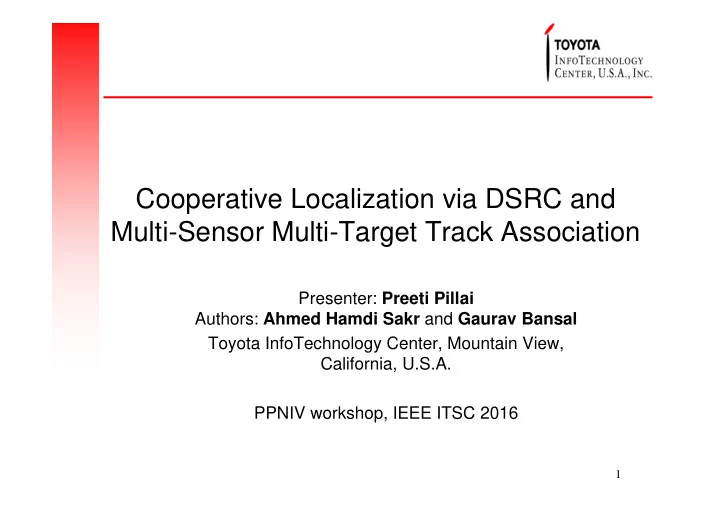

Cooperative Localization via DSRC and Multi-Sensor Multi-Target Track Association Presenter: Preeti Pillai Authors: Ahmed Hamdi Sakr and Gaurav Bansal Toyota InfoTechnology Center, Mountain View, California, U.S.A. PPNIV workshop, IEEE ITSC 2016 1
Outline • Overview of the Proposed System • Positioning Improvement System • Performance Evaluation and Results 2
Outline • Overview of the Proposed System • Positioning Improvement System • Performance Evaluation and Results 3
DSRC Technology Basic Safety Message (BSM) • DSRC: Dedicated Short-Range Item Communication Time 3D Position – Ad hoc networking technology that Position Accuracy allows vehicles to communicate Speed Heading with each other, roadside devices, Steering Wheel Angle bicycles, pedestrians, trains, etc. Acceleration Brake Status • An active research for many Vehicle Size years. Event Flags Path History • Moving toward deployment. Path Prediction Other optional fields • Many stakeholders in US and elsewhere. • Goal: use DSRC Basic Safety Messages to improve localization. 4
Main Idea • The host vehicle (HV) uses Kalman filters (KF) to fuse position information from two independent sources to reduce the uncertainty of the measurements. • The two sources are: 1. its own position information obtained by the on-board GPS receiver. 2. position information of nearby vehicles (RV) collected by an on-board ranging sensor (RS) and the messages received via the DSRC transceiver from other equipped vehicles. 5
Example • GPS of HV reports (1.25,-0.9). • 2 RVs send their position to HV as: (-4.1,6.25), (3.5,9). • 3 RVs are detected by an RS at: (6.9,-28.5°), (8.25,23°), (8.93,2°) =(-4.5,6,96), (0.94,9.8), (4.5,8.5). • After matching vehicles, 2 estimates of HV position are: – (-4.1,6.25) - (6.9,-28.5°) = (-0.81,0.19) – (3.5,9) - (8.25,23°) = (0.27,1.4) • Take the average* of all estimates, HV is estimated at (0.24,0.23) with 0.33 m error which is 78% more accurate compared to (1.25,- 0.9) with 1.54 m error. * Note that using the average is just an example, in our proposed method, we use a Kalman filter-based approach to fuse data. 6
Outline • Overview of the Proposed System • Positioning Improvement System • Performance Evaluation and Results 7
Positioning Improvement System • The proposed solution consists of three steps: 1. Tracking and synchronization. 2. Multi-sensor multi-target track association (MTA). 3. Data fusion. 8
Tracking and Synchronization • KF has been proven to be optimal for tracking under linear Gaussian noise assumption. • Hence, each HV has N KFs to track N RVs based on an age threshold and prioritization. • DSRC messages arrive at different times and not synchronized. • A zero-gain open-loop KF is used for synchronization to predict the position at any given time instant. 9
Track Association (MTA) • DSRC detects a set of N RVs. • Ranging sensor detects a set of K RVs. • K and N are not necessarily equal. • A Multi-sensor Multi-target Track Association problem to find the intersection between the two sets. • Calculate the statistical distance • Each match has to pass a validation gate: � � : Distance at time k � : History window size � � : Covariance at time k 1 � � : Confidence region � : Chi-square distribution � : Position of vehicle � at time k χ �� � � 10
11 Track Association (MTA)
Data Fusion • Combine the different estimates of the position of the HV into one solution. • The inputs to DF-KF are: – position information of the HV obtained by its on-board GPS receiver. – position estimates of the HV derived from the position of nearby RVs that are simultaneously detected by the RS and DSRC receiver. • In the worst case, the DF-KF has only one input from the on-board GPS receiver when: – No RVs are detected by the RS, – No BSM messages are received by the DSRC transceiver, or – No matching is found. • This case is equivalent to the baseline case. 12
Outline • Overview of the Proposed System • Positioning Improvement System • Performance Evaluation and Results 13
Performance Evaluation • MATLAB-based simulation. • Car-following model where the acceleration of a vehicle is evaluated based on the current position and velocity of the leading vehicle: • GPS errors are assumed to be Gaussian-distributed with zero mean. • Standard deviation and correlation coefficient of GPS errors are obtained experimentally. �� : Accelation � : Separation distance �� : Velocity � � : Position error weighting parameter � : Position of vehicle � � : Velocity error weighting parameter 14
15 Simulation Parameters • Simulation parameters:
Performance Metrics • Mean Squared Error (MSE): average of the squares of the deviations between the true position and the estimated position of the HV: • MSE reduction: the reduction of MSE gained by using the proposed approach compared to the baseline case: • Track matching accuracy (TMA): the percentage of correct matching decisions taken by the MTA algorithm. 16
MSE vs. N 43.8% improvement 1 RV 57.8% improvement 2 RVs 74.2% improvement 5 RVs 17
18 TMA vs. Spatial Error
Conclusions • We proposed an algorithm to improve HV positioning combining GPS data, DSRC BSMs, and ranging sensor tracks. • After performing track association, HV uses a Kalman filters-based approach to fuse information from different sensors. • Simulation results show that our algorithm highly improves positioning and reduces spatial errors. • The effect of correlation is also studied and we show that the proposed system is beneficial even when errors at nearby GPS receivers are correlated. • Future Work: – Modelling errors in urban environments. – Conducting field experimentations. 19
Questions.. Ahmed Hamdi Sakr ahmed.sakr@umanitoba.ca Gaurav Bansal gbansal@us.toyota-itc.com 20
Recommend
More recommend